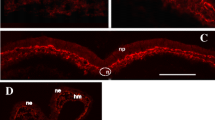Summary
The effect of laminin (LN) on the attachment and differentiation of a human retinoblastoma cell line (Y-79) was investigated. We found that 10 μg/ml LN in the serum-free culture medium for 3 to 4 d induces 20 to 30% of the cells to firmly attach to a plastic substratum. This effect seems to be complex because the short-term effect of LN is inhibition of cell attachment. The specificity of LN may be indicated because antilaminin antibody counteracted this effect. The attached cells form small processes immediately after attachment and continue to proliferate, forming small colonies. Treatment of these cells with 4 mM dibutyryl-cyclic AMP (db-cAMP) or 2 mM sodium butyrate starting on the 3rd or 4th d of culture results in extensive differentiation of all the attached cells. Db-cAMP provokes the formation of long ramifying neuritelike processes whereas butyrate induces the appearance of epithelial-like cells with a flat morphology. Thus, laminin seems to act in concert with other agents promoting attachment and potentiating differentiation.
Similar content being viewed by others
References
Bottenstein, J. B. Serum-free culture of neuroblastoma cells. In: Evans, A. E., ed. Progress in cancer research and therapy. vol 12. New York: Raven Press; 1980:161–170.
Chung, A. E.; Jaffe, R.; Freeman, J. L. et al. Properties of a basement membrane-related glycoprotein synthesized in culture by mouse embryonal carcinoma derived cell line. Cell 16:277–287; 1979.
Edgar, D.; Trimpl, R.; Thoenen, H. The heparin-binding domain of laminin is responsible for its effects on neurite outgrowth and neuronal survival. EMBO J. 3:1463–1468; 1984.
Kleinman, H. K.; Klebe, R. J.; Martin, G. R. Role of collagenous matrices in the adhesion and growth of cells. J. Cell Biol. 88:473–485; 1981.
Kleinman, H. K.; McGarvey, M. L.; Liotta, L. A., et al. Isolation and characterization of type IV procollagen, laminin and heparin sulfate proteoglycan from the EHS sarcoma. Biochemistry 21:6188–6193; 1982.
Kyritsis, A. P.; Tsokos, M.; Chader, G. J. Attachment culture of human retinoblastoma cells: Long-term culture conditions and effects of dibutyryl-cAMP. Exp. Eye Res. 38:411–421; 1984.
Kyritsis, A. P.; Tsokos, M.; Triche, J. J., et al. Retinoblastoma: origin from a primitive neuroectodermal cell? Nature 307:471–473; 1984.
Lander, A.; Fujii, D.; Reichardt, L. Laminin is associated with the “neurite outgrowth-promoting factors; found in conditioned media’. Proc. Natl. Acad. Sci. USA 82:2183–2187; 1985.
Liesi, P.; Dahl, D.; Vaheri, A. Laminin is produced by early rat astrocytes in primary culture. J. Cell Biol. 96:920–924; 1983.
Manthorpe, M.; Engrall, E.; Ruoslahti, E., et al. Laminin promotes neuritic regeneration from cultured peripheral and central neurons. J. Cell Biol. 97:1882–1890; 1983.
McGarrity, G. J.; Carson, D. A. Adenosine phosphorylase mediated nucleoside toxicity: application towards the detection of mycoplasmal infection in mammalian cell cultures. Exp. Cell Res. 139:199–206; 1982.
Pfeffer, B.; Wiggert, B.; Lee, L., et al. The presence of a soluble interphotoreceptor retinol-binding protein (IRBP) in the retinal interphotoreceptor space. J. Cell Physiol. 117:333–341; 1983.
Redmond, T. M.; Wiggert, B.; Robey, F., et al. Isolation and characterization of monkey interphotoreceptor retinoid-binding protein, a unique extracellular matrix component of the retina. Biochemistry 24:787–793; 1985.
Reid, T. W.; Albert, D. M.; Rabson, A. S., et al. Characteristics of an established cell line of retinoblastoma. J. Natl. Cancer Inst. 53:347–360; 1974.
Rogers, S. L.; Letourneau, P. C.; Palm, S. L., et al. Neurite extension by peripheral and central nervous system neurons in response to substratum-bound fibronectin and laminin. Dev. Biol. 98:212–220; 1983.
Smalheiser, N. R.; Crain, S. M.; Reid, L. M. Laminin as a substrate for retinal axons in vitro. Dev. Brain Res. 12:136–140; 1984.
Timpl., R.; Rohde, H.; Gehron-Robey, P., et al. Laminin—a glycoprotein from basement membranes. J. Biol. Chem. 254:9933–9937; 1979.
Author information
Authors and Affiliations
Rights and permissions
About this article
Cite this article
Kyritsis, A.P., Fletcher, R.T. & Chader, G.J. Laminin: An initiating role in retinoblastoma cell attachment and differentiation. In Vitro Cell Dev Biol 22, 418–422 (1986). https://doi.org/10.1007/BF02623532
Received:
Accepted:
Issue Date:
DOI: https://doi.org/10.1007/BF02623532




